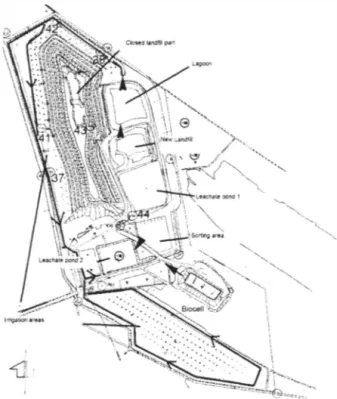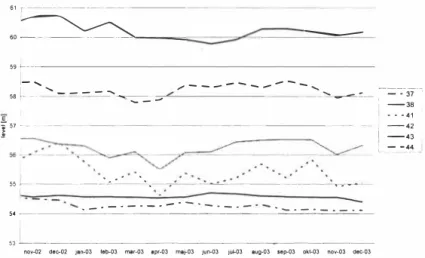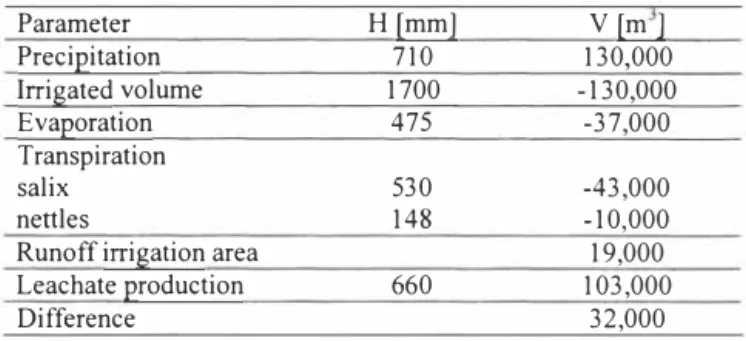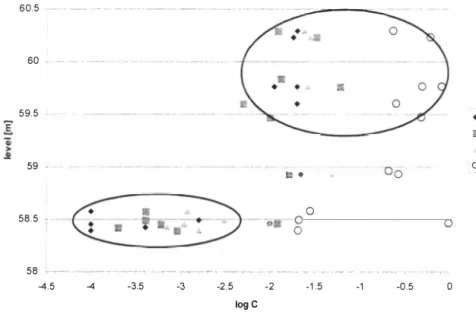Kalmar ECO-TECH '05 and
The Second Baltic Symposium on Environmental Chemistry KALMAR, SWEDEN, November 28-30, 2005
EFFICIENCY CONTROL OF LANDFILL
LEACHATE IRRIGATION ON ENERGY CROPS
Erik Kar/sson
1Martijn van Praagh
2Kenneth M. Persson
3 1Kommunal Teknik Trelleborg, Sweden
2Lund University, Sweden
3Sweco Viak, Sweden
ABSTRACT
Leachate constitutes the major long-term em1ss1on from landfills. A possible treatment method is collection and subsequent irrigation on short rotation coppice during the growing season, for example onto willow stands (salix). Theoretically, irrigation allows both a volume reduction and a reduction of potentially hazardous leachate contents, such as nitrogen, organic carbon and heavy metals. In this work, both hydraulic and reductive efficacy of leachate irrigation at the municipal solid waste landfill Ronneholm, in Southern Sweden, have been investigated by means of a water and a mass balance. For the latter, the emission values of copper, chromium, nickel, zinc and total nitrogen were used, This study covers the period from November 2002 until December 2003. The water balance and the mass balance were modelled with a straight-forward box-model. The results suggest the importance of favourable irrigation schemes and the importance of sedimentation for leachate heavy metal reduction. Water balance calculations pinpointed potential for improving the efficiency of the leachate volume reduction. In addition, the susceptibility of emission values for short term water level changes was checked by daily sampling during a week, at a across section of the landfill. Initial results suggest that measured heavy metal concentrations fluctuate with water levels in the landfill body. This might be utilised to optimise irrigation schemes. A simple water and mass balance model has proved to be an effective method to both control leachate treatment and to serve as a starting point to develop leachate reduction schemes.
KEYWORDS
Landfill leachate; Irrigation; Energy crop; Water balance; Mass balance; Leachate management
I INTRODUCTION
Due to its heavy metal, ammonia and organic carbon content, many leachates from municipal solid waste (MSW) landfills can pose a threat to the environment, especially to subsurface and surface waters. Treatment is necessary, and depending on the exact composition of the liquid emissions, a variety of treatment methods are applied in full scale. Chemical or biological treatment or a combination thereof, as well as thermal treatment or mechanical treatment methods, such as sedimentation, are applied around the world in different sizes and setups [ 1]. Instead of treating the leachate up to a quality acceptable for discharge into a recipient, the leachate from MSW landfills can often be used beneficially as a fertiliser. Due to ammonia and phosphate content, irrigation on short rotation crops has been used both for volume and content reduction [2]. This study aims to control the efficiency of a large scale irrigation scheme by means of a water balance and a mass balance for nitrogen, organic carbon, copper, chromium, nickel and zinc with a straight-forward model.
2 THE RONNEHOLM LANDFILL
The full scale MSW landfill at Ronneholm landfill, situated near the village Stehag in Scania, Southern Sweden, has been operated partly with an irrigation system on energy crops since 1986. It is run by the municipal owned company MERAS. From 1967 until 1994 mainly municipal solid waste has been disposed of. The irrigated part of the landfill has been provided with a final cover. It consists of composted sludge from waste water treatment and a final soil layer on top, which was finalised during the summer of the year 2000. The slopes are covered with clay and a final layer of soil. A system of outer and inner ditches, divided by low permeability clay walls, surrounds the landfill. The leachate and surface runoff is passively collected in the inner ditches and let to a pond. The water level is kept lower in these inner drenches than in the outer, parallel ditches, in order to have a hydraulic gradient towards the landfill. During the growing season the leachate is irrigated onto energy forest, which partly covers the landfill itself (43 and 35 hectare, respectively). Thus, apart from plant uptake and evaporation, the leachate is partly re-circulated (see Figure 1). An active and uncovered industrial landfill, a biocell and a sorting area are included in the hydrological system, as well as a total of two leachate ponds and a lagoon. The latter are occasionally used to reduce water levels in the lower leachate pond. Apart from the irrigation volume and the water level in the lower pond, no hydrological parameters were evaluated on site.
Kalmar ECO-TECH ·05 and
The Second Baltic Symposium on Environmental Chemistry KALMAR, SWEDEN, November 28-30, 2005
Stale 1:5000
Figure 1. Flow path of leachate and runoff at Ronneholm landfill.
The Riinneholm Landfill is situated on the Ringsjii fault. The bedrock consists of gneiss, which is covered by glacial till, between 5 and JO meter thick [3]. In the Northeast of the landfill lies the Riinneholm bog. It has been extensively harvested. Within the landfill area, a layer of lime gyttja lies underneath the residual peat. Silt can be found directly under the landfill, in some areas less than 50 cm thick.
3 WATER AND MASS BALANCES
day n+1 n n-1 lfn-1.l-1 '---+---,e---+---1>box �1
Figure 2. Box model calculation
The water content in each box is calculated by equation (I).
vn,, = !Fn-1,box,-I + vn-1,, + IRRn-1 - p ERn-1 - OUTn-1,, (I) Where V0,; stands for the retained mass of water in box i at time n, IF0_ 1,box;_1 for the interflow of one box to the next (calculated with Darcy's Law under the assumption that the material is saturated), V n-1,i for the retained mass of water in box i at time n-1, IRR0_1 for the irrigation and precipitation contribution from time n-1, PER0_ 1 for the percolation from box i into the waste, which becomes leachate at the lowest layer of boxes, and OUT n-Li represents the outflow, in the calculations divided as surface runoff and evapotranspiration for the first layer and interflow for the subsequent layers. Precipitation and temperature were registered at a nearby weather station. At temperatures below O degree Celsius the precipitation was assumed to fall as snow. It was included in the calculations as rain runoff, as soon as the temperature rose to above O degree Celsius again. As the snow only amounts to 5% of the precipitation measured by height, the influence of this simplification on the overall balance is regarded small. Due to a lack of measuring instruments, the evaporation was calculated from values in a study on the water balance of a catchment area in Southern Sweden, where the annual solar radiation and wind speeds are in comparable order of magnitudes [4].
Transpiration for the energy crop was determined according to values for sa/ix calculated in a different study in Southern Sweden [5]. Apart from sa/ix, the landfill is partly covered with nettles. For these parts a value obtained from a Danish heath was taken from [6] as a rough approximation. For the waste body itself three permeability values have been tested, I
o·
8, 10·7 and I 0-5 mis, of which the latter two gave highly inconsistent results, which are not shown. The hydraulic properties of the three modelled parts of the final cover can be derived from Table 1.I :3
55 i--- . ---��--• __ ·' .-�--�---��
Kalmar ECO-TECH ·05 and
The Second Baltic Symposium on Environmental Chemistry KALMAR, SWEDEN, November 28-30, 2005
Table 1. Hydraulic paramelersfor the water balance.
Part Porositr Effektiv 2orositr Penneabilitr Inclination
Larer I 0,35 0,3 10·8
Layer 2 0,35 0,3 10•7 1:10
Larer 3 0,35 0,3 10· 1:10
3.2 Water level observations
The water table in the landfill is measured by the operator at several bore holes. Observations points used in this study are displayed in Figure 1 as numbers 37, 38 and 41 to 44. For the water table fluctuation during the period studied in this work see Figure 3. The water fluctuation inside the landfill body was subsequently calculated by interpolation between the isoclines, and could be compared to the percolation calculated by the box-method. The water level in the lower leachate pond (pond 2 in Figure 1) is registered on a daily basis, and it could be compared to the calculated water balance values. The volumes from open surface areas were corrected for evaporation .
., r--- ---
-" �
"t:-
-,
,,,,---ss
r---
' - -
-
-
-
-
-
---�
�
-
-
-
-
_
...---� �
=
--=-:r,1
-38 • • • 41i
57 •··-i
=:!
L =---4_◄___1 I" _____.
_
-
_
.
_
-
_
·
_
-
__
· -_-_-
_
·
_-_-_-_·_-_·_-
__
·_-_. _-_·_-_._-_.
-- - 53---nov-02 dec-02 Ja!'l-03 feb-03 mar-03 apr-03 maj-03 Jur.-03 JUl-03 aug-03 sep-03 okt-03 nov-03 dec-03Figure 3. Waler levels for water balance calculations, measured above sea level.
3.3 Box model for the mass transport
475
Measured concentrations were in the range of those reported from other Swedish landfills [8) and comparable to those used in a former uptake study [7]. Plant uptake performances of 90, 84, 72 and 99 % for Cr, Cu, Ni and Zn, respectively, were used for the growing season. As concentration changes in the leachate are small over the studied 13 month, the simplification of equalling water and solute movement should not lead to large mistakes. The accumulation of heavy metals in the soil was not accounted for, as it has been shown to be negligible in [2]. The atmospheric deposition for total nitrogen was assumed to be 0.8g/box.
3.4 Sampling and analytical procedures
Sampling followed the recommendations given in (9). To initially investigate the efficiency of heavy metal removal by sedimentation, core samples were taken and analysed. Horizontal slices were cut out and analysed for the heavy metals, nitrogen, carbon and dried solid content. The heavy metals where analysed by ICP-AES. TOC and total N were analysed by "elementanalyser" model Vario MAX CN. Total solids where determined by weight after 24 hours drying at 105 degrees C.
4 RESULTS AND DISCUSSION
4.1 Water balance results
The water balance parameters are summarised in Table 2. Water withdrawn from the landfill's hydrological system is indicated by a negative sign. A lack of 32,000 m3 in respect
to the irrigated volume could be explained by groundwater intrusion, which has been suspected by the operators previously. Another explanation can be poor values for the calculated leachate production, and/or actually lower values for evaporation. A recalculation suggests a possible groundwater flow of Jess than 1
o-
8mis
averaged over the whole landfill area, which is a realistic order of magnitude. High fluctuations of collected leachate have been discovered earlier [3]. Even groundwater intrusion has been shown indirectly elsewhere [JO]. For verification, the calculations have been varied in respect to permeability of both the waste and the cover layers, but this did not have a significant effect on the fit of the model results. The simplifications of assuming saturated layers during the whole studied period and the neglect of the landfill top (which is plane and regarded not to produce runoff) is likely to cause deviations, although not likely in this magnitude.Table 2. Water balance parameters Ronneholm Landfill 11/2002 till 1212003.
Parameter H [mm] V (m] Precipitation 710 130,000 Irrigated volume 1700 Evaporation -130,000 -37,000 Transpiration salix 530 -43,000 nettles 148 -10,000
Runoff irrigation area 19,000
Leachate production 660 103,000
350
0.3
Kalmar ECO-TECH ' 05 and
The Second Baltic Symposium on Environmental Chemistry KA LMAR, SWEDEN, November 28-30, 2005
4.2 Mass balance results
The results for the mass transports through the landfill are comprised in Tables 3 and 4. Runoff values for the heavy metals were not calculated. Atmospheric deposition of heavy metals was neglected, due to reported values in the 10-1 to 10-2 µg/L range, see for example in [ I I ]. The mass reduction rates are lower than those reported in [2] and (11]. This can be explained by the unfavourable irrigation scheme during 5 winter months, and a failure during a month in the summer. Sediment contents are given in Table 5. Interestingly, the values in the upper two layers are elevated, although the total solids and carbon content only show slight differences. This might be a consequence of the more recently started operation of the industrial waste landfill site within the hydrological system. This is not reflected in the concentration values in the leachate (not shown). Another possibility is different redox-ranges in the sediment, which have not been measured.
Table 3. Nitrogen transport through the Ronneholm hydraulic system.
Irrigation N [kg] Atm. deposition 140 I) Plant uptake 2> 460 Percolation 2> Leachate 2600 production Runoff
!)Literature value for average yearly concentration: l mg/L [I I];
2> denitrification in the soil is not included; 3) 90% of irrigated mass (1 1].
Table 4. Heavy metal flows within the Ronneholm Landfill hydraulic system.
Heavy metal Cr [kg] Cu [kg] Ni [kg] Zn [kg] Irrigated mass I . I 5.2 22.2 17.5 Precipitation I) Plant uptake 0.6 4.2 3.3 Percolation 0.8 4.6 18 14.2 Production 1 1 20 44 41
---
-
-
-
--
-
-::,;
-
--
-
---�
4.3 Water levels and concentrations
The heavy metal concentrations varied with the water level inside the landfill. A slight trend to higher concentrations with an elevated water level is suggested, see Figure 4.
60.5 ---- - -- -- -- - --- ---- --- -60 · -59.5 Ni 59 - - o zn
n •
lllli ♦ Cr wcu 0 58.5 J _I 58 r-� · --�---�---- -- --,---..�--- • - --• -- ,--- - � ·- ·- -- - �---4.5 -4 -3.5 -3 -2 .5 -2 -1 .5 -1 -0.5 0 log CFigure 4. Logarithmic heavy metal concentrations versus water levels in point nr. 43.
5 CONCLUSIONS
A straight-forward box model with minimal input data has been able to model the water balance of a soil based final landfill cover with energy crop vegetation within reasonable orders of magnitude. A possible groundwater intrusion is suggested, and optimisation potential through adjusting irrigation schemes to the soil water budget has been shown. Further investigations of the exact amount of plant uptake and heavy metal caption in the leachate sediment should be done. Heavy metal concentrations in the leachate might move with water table elevations inside the landfill. Further work should concentrate on hydrological and chemical leachate deviations, as they could be utilised to greatly enhance water and/or metal removal.
ACKNOWLEDGEMENTS
The help of the staff at the Ronneholm landfill and at MERAB, as of the former CEO, Gabriella Eliasson, is gratefully acknowledged, as is the overall financial support of the research project "Environmental impact of altered landfills", which this study was a part of, by RVF, SYSAV Utvecklings AB and Fysiografiska Sallskapet in Lund.
Kalmar ECO-TECH '05 and
The Second Baltic Symposium on Environmental Chemistry KALMAR, SWEDEN, November 28-30, 2005 REFERENCES
[ I ) Lagerkvist, A., 2001. Landfill Technology. Technical Reporr, Lulea Technical University, ISSN: 1402- 1536.
[2) Hasselgren, K., Nilsson, P., 1992. Leachate treatment: On site methods for landfill leachate treatment. Technical Report. Report Nr. 4052. Swedish Environmental Protection Agency (in Swedish).
[3) Bjorngreen, M., 1996. Monitoring Programs for landfills. Master Thesis at Technical Geology Department, Lund University, Lund, Sweden.
(4) Anonymous, 2004. Swedish hydrological institute (SMHI). www.asmhi.ase.
[5] Halldin, J., Lindroth, A., 1988. Water consumption and irrigation needs of energy crops in Gotaland and Svealand. Vatten 44, I (in Swedish).
[6] Hansen, B., Ladekarl, U.L., Nilesen, K.E., Nornberg, P., 2001. Effects of a heather beetle attack on soil moisture and water balance at a Danish heathland. Plant and Soil. 229, I .
[7] Bevmo, L., Hasselgren, K., Persson, K.M., 2000. Leachate treatment today and tomorrow-technical review and some thoughts. Vatten. 4 (in Swedish).
[8) Oman, C., Malmberg, M., Wolf-Watz, C., 2000. Manual for characterization of leachate. RVF rapport 00:7. IVL Swedish Environmental Institute Lim. (in Swedish). [9] Oman, C., Malmberg, M., Wolf-Watz, C., 2000. Development of methods for
characterisation of landfill leachate. RVF rapport 00:3. IVL Swedish Environmental Institute Lim. (in Swedish).
[ IO] Van Praagh, M., Persson, K.M., 2004. Reconsidering Landfill Monitoring with the Aid of Multivariate Data Analysis. In: Waste Management and the Environment II, 449-458, W!Tpress, Southampton.
[ 1 1] Hedmann, A., 2000. Irrigation of energy crops at Tagene Landfill, Gothenburg. RVF rapport 00:4. RVF-The Swedish Association of Waste Management (in Swedish).




